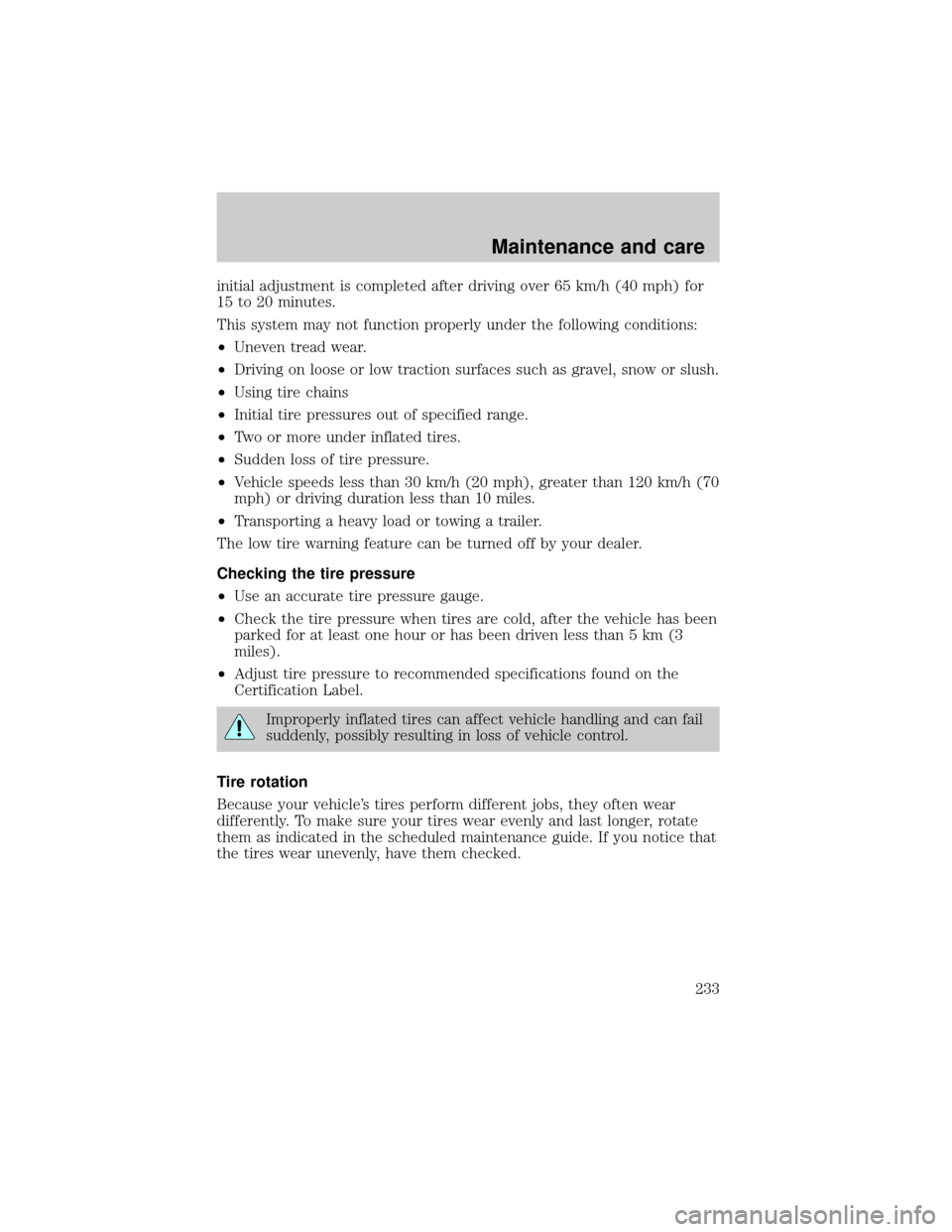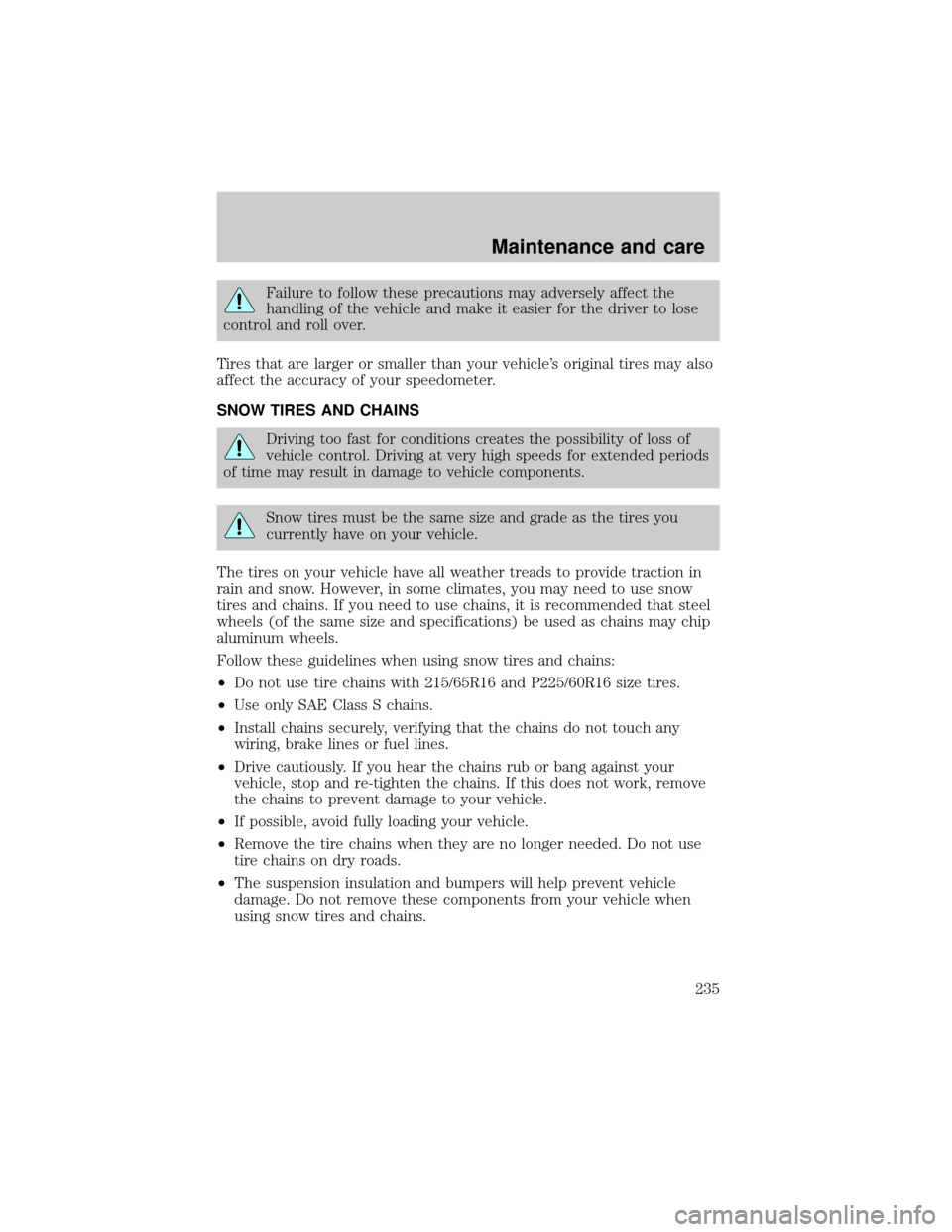snow chains FORD WINDSTAR 2001 2.G Owners Manual
[x] Cancel search | Manufacturer: FORD, Model Year: 2001, Model line: WINDSTAR, Model: FORD WINDSTAR 2001 2.GPages: 288, PDF Size: 2.6 MB
Page 233 of 288

initial adjustment is completed after driving over 65 km/h (40 mph) for
15 to 20 minutes.
This system may not function properly under the following conditions:
²Uneven tread wear.
²Driving on loose or low traction surfaces such as gravel, snow or slush.
²Using tire chains
²Initial tire pressures out of specified range.
²Two or more under inflated tires.
²Sudden loss of tire pressure.
²Vehicle speeds less than 30 km/h (20 mph), greater than 120 km/h (70
mph) or driving duration less than 10 miles.
²Transporting a heavy load or towing a trailer.
The low tire warning feature can be turned off by your dealer.
Checking the tire pressure
²Use an accurate tire pressure gauge.
²Check the tire pressure when tires are cold, after the vehicle has been
parked for at least one hour or has been driven less than 5 km (3
miles).
²Adjust tire pressure to recommended specifications found on the
Certification Label.
Improperly inflated tires can affect vehicle handling and can fail
suddenly, possibly resulting in loss of vehicle control.
Tire rotation
Because your vehicle's tires perform different jobs, they often wear
differently. To make sure your tires wear evenly and last longer, rotate
them as indicated in the scheduled maintenance guide. If you notice that
the tires wear unevenly, have them checked.
Maintenance and care
233
Page 235 of 288

Failure to follow these precautions may adversely affect the
handling of the vehicle and make it easier for the driver to lose
control and roll over.
Tires that are larger or smaller than your vehicle's original tires may also
affect the accuracy of your speedometer.
SNOW TIRES AND CHAINS
Driving too fast for conditions creates the possibility of loss of
vehicle control. Driving at very high speeds for extended periods
of time may result in damage to vehicle components.
Snow tires must be the same size and grade as the tires you
currently have on your vehicle.
The tires on your vehicle have all weather treads to provide traction in
rain and snow. However, in some climates, you may need to use snow
tires and chains. If you need to use chains, it is recommended that steel
wheels (of the same size and specifications) be used as chains may chip
aluminum wheels.
Follow these guidelines when using snow tires and chains:
²Do not use tire chains with 215/65R16 and P225/60R16 size tires.
²Use only SAE Class S chains.
²Install chains securely, verifying that the chains do not touch any
wiring, brake lines or fuel lines.
²Drive cautiously. If you hear the chains rub or bang against your
vehicle, stop and re-tighten the chains. If this does not work, remove
the chains to prevent damage to your vehicle.
²If possible, avoid fully loading your vehicle.
²Remove the tire chains when they are no longer needed. Do not use
tire chains on dry roads.
²The suspension insulation and bumpers will help prevent vehicle
damage. Do not remove these components from your vehicle when
using snow tires and chains.
Maintenance and care
235
Page 283 of 288

cleaning the
safety belts ......................143, 256
extension assembly ................139
for adults .........................135±137
for children .....................151±152
lap belt ....................................138
Occupant Classification
Sensor ......................................132
warning light and
chime ...............9, 13±14, 139±140
Safety seats for children ..........153
Seat belts
(see Safety restraints) .............131
Seats ..........................................119
child safety seats ....................153
cleaning ...........................256±257
memory seat .............89, 109, 122
SecuriLock passive
anti-theft system ...............113±115
Servicing your vehicle ..............208
Spark plugs,
specifications .....................257, 261
Specification chart,
lubricants ...........................259, 261
Speed control ..............................79
Speedometer ...............................15
Starting your vehicle ........163, 165
jump starting ..........................202
Steering wheel
tilting .........................................84T
Tachometer .................................15
Tires ...........................196, 230±232
changing ..................196±197, 199
checking the pressure ............233
replacing ..................................234
rotating ....................................233
snow tires and chains ............235
tire grades ...............................231
treadwear ................................231
Towing .......................................180
recreational towing .................183
trailer towing ..........................180
wrecker ....................................207
Traction control ..................78, 169
active light ..................................8
off light ........................................9
Transaxle
automatic operation ...............173
fluid, refill capacities ..............258
lubricant specifications ..........261
Transmission
fluid, checking and adding
(automatic) .............................222
lubricant specifications ..........259
Trip odometer .............................16
Turn signal ........................9, 14, 82
V
Vehicle dimensions ...................261
Vehicle Identification Number
(VIN) ..........................................263
Vehicle loading ..........................178
Ventilating your vehicle ...........166
Index
283